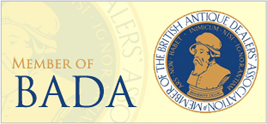| Steppes Hill Farm Antiques Newsletter #55 - March 2016 |
 |


George IV Cast Silver Wine Label by Edward Farrell, London 1822
Please click on the photograph to see more details
To "Tope", is to drink (liquor) habitually and excessively or engage in such drinking.Synonyms for "Toper" include; alcoholic, bacchanal, boozer, carouser, debaucher,dipsomaniac, inebriate, lush, soak, sot, souse, sponge, tippler, barfly and bibber.
Drinking alcohol to excess and on a regular basis appears to have been a popular pastime inEurope during the Georgian and Victorian eras and it is not difficult to find works of artcelebrating the pursuit, particularly by the Dutch Masters, where of course the spirit Gin wasinvented in the early 17th century.
 |
Frans Hals,1580-1666, painted one of his mostfamous paintings "The Merry Drinker", in1628-30. Influenced by the art of Rubens andCaravaggio, Hals went a step farther andpainted the immediacy of the moment, fardifferent from the dignified, pre-arrangedaristocratic portrait style of van Dyck.
In his portrait "Merry Drinker", the figureraises his right hand in grasping fashion readyto catch a wine glass the instant it falls provinghis state of sobriety. His face however betraysthe action. His eyelids are heavy and his mouthhangs open proving what we knew all alonghe's a bit over the line; or he wouldn't be actingthis way. As the title "The Merry Drinker"suggests, it's all in fun and Hals has capturedthis moment in his art. While Rubens andCaravaggio have a more composed staged artstyle in portraiture, Frans Hals paints theimpression he has just caught the sitter in amomentary action. |
 |
The Jolly Toper is an oil painting by JudithLeyster in the collection of the Rijksmuseum inAmsterdam that is on long term loan to theFrans Hals Museum since 1959. It wasacquired by the museum as a painting by FransHals and was attributed to Leyster by theresearcher Juliane Harms in 1927. The paintingwas sold in Hotel Drouot in Paris in 1890 as byHals or a son to Schiff and was bought by theRijksmuseum in 1897. The painting is signedand dated on the back wall above the tankard.The scene shows the popular Peeckelhaeringhfigure in 17th-century comic plays. ThePeeckelhaeringh or Pekelharing character isoften shown as a "Kannenkijker", or jug-looker.This is a signal that the mug is empty and theshow is over. |

Alexis Grimou - Self-portrait as a Drinker ('The Toper')
Grimou painted a number of self-portraits of this type, their roots can be found in Dutchseventeenth-century art. He shows himself as a jolly drinker, raising his wine glass as iftoasting the viewer, and grasping the decanter of wine in his other hand. On the table in frontof him are the remains of his meal of bread and cured sausage. This example is very similarto two other versions in private collections, one of which bears a partly visible date in the1730s, possibly 1732 (the year before his death). An earlier variation on this theme isrepresented by his Self-portrait in the Louvre dating from 1824, and a further variation, inwhich the artist wears a floppy hat, is in Worcester Art Museum.

Jacob Jordaens - The King Drinks
Jordaens painted several versions of this subject, including one c. 1640 work in the RoyalMuseum of Art, Brussels. On January 6, Epiphany is celebrated in Flanders. It is acelebration of food, wine and merriment that is shared with family. One person gets to beking for the evening, which as Jordaens thoughtfully depicts as the eldest person in the room.The rest of his subjects are assigned by him. The painting shows that emotions are runninghigh, with people's extremely boisterous expressions. There seems to be a brawl that is aboutto erupt and the expression of the man who is vomiting seems all too pitiful. Jordaens usesthis painting to express his distaste for drunkenness with the motto inscribed at the top thattranslates "Nothing seems more like a madman than a drunkard".

The fine Georgian cast silver Wine Label by Edward Farrell illustrated above depicts fiverevelling Dutchmen in various attitudes surrounding the label either drinking or smoking andcertainly enjoying themselves. Possibly after a painting by Teniers.

Once again I am pleased to be able to update the site this month with over 40 new items ofstock and some highlights include; a Victorian silver gilt 'Stag Hunt' pattern Sifter Spoon, aWilliam IV Armorial silver Wine Label depicting the crest of the Ffolkes family, anextremely rare Victorian novelty silver combined Propelling Pencil and Whistle depicting ababy in swaddling clothes, an unusual Victorian cased silver Pen & Pencil Set, a Victoriannovelty silver Hand Quill Holder with ebony shaft, a George V Patented silver RevolvingTable Vesta Box, an Edwardian novelty silver Lizard Pin Cushion, and a Victorian silver Eggshaped Sewing Etui.

Please make sure and check out the latest articles in our Blog, for all the latest news in the silver world and some other interesting features

I do hope that you will find this Newsletter informative and helpful and will allow us send it to you on a regular basis. I would welcome any feedback you may have, both positive and negative.
David W.A. Buck.
Steppes Hill Farm Antiques |
|

 |
 |
|

